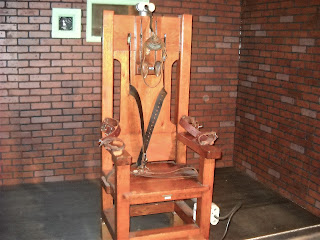Electric Chair
Execution via electric chair is believed to be a humane and painless method. However, it does not look as such from an onlooker's perspective, as the prisoner often appears to be thrashing, their eyeballs often melt and/or pop out of their skull, involuntary bowel movement occurs, and the smell of burning skin is prevalent. Autopsies of convicts executed in this way often showed that the brain had literally been cooked inside the skull. Thus, the question arises, how is that a humane and painless execution?
Death by electrocution is caused by high voltage electricity resulting in rapid and irregular contractions of the heart, thus causing cardiac arrest. For the execution in an electric chair, the prisoner's hair is removed from one of their legs and their head in order to connect electrodes to the skin. They are strapped to the chair. Then, an initial high voltage (usually around 2000 V) alternating current is applied for about 30 seconds, which makes the convict lose consciousness. If death does not occur immediately, further lower voltage jolts of electricity are applied in intervals, until they die. Thus any potential pain is seemingly experienced for only a few seconds.
Nevertheless, several cases have been documented where the chair malfunctioned. Some prisoners have been observed to shriek in pain while being executed. For example, the 17-year old murder suspect, Willie Francis, was sentenced to be executed in 1946 in the Louisiana electric chair, then known as Gruesome Gertie. The executioners were seen to be visibly drunk when the time came. The initial electric shock caused Francis to scream and thrash without dying. It was believed that an unexpected malfunction of the chair was to blame and thus a second execution was scheduled to take place the following year. That one was successful.
Another example of a botched electric chair execution was that of John Evans in 1983 in Alabama. After the application of the first electric shock Evans' leg and head were seen to have burst into flames. Upon a medical examination, a heartbeat was detected. Thus, a second shock was administered, again causing more burning but not killing the convict. However, the third and final shock did the job. Those who witnessed the execution were left with the unpleasant memory of a "cruel and unusual punishment". Because of these and many other similar examples of flaws in electric chair executions, the method had been outlawed in most states.
Fun fact: the electric chair was invented by a dentist, A. Southwick. He and the physician G. Fell experimented on stray dogs to establish the effectiveness of this method of euthanisation. One of the early designs was a modified dental chair with restraints.
Death by electrocution is caused by high voltage electricity resulting in rapid and irregular contractions of the heart, thus causing cardiac arrest. For the execution in an electric chair, the prisoner's hair is removed from one of their legs and their head in order to connect electrodes to the skin. They are strapped to the chair. Then, an initial high voltage (usually around 2000 V) alternating current is applied for about 30 seconds, which makes the convict lose consciousness. If death does not occur immediately, further lower voltage jolts of electricity are applied in intervals, until they die. Thus any potential pain is seemingly experienced for only a few seconds.
Nevertheless, several cases have been documented where the chair malfunctioned. Some prisoners have been observed to shriek in pain while being executed. For example, the 17-year old murder suspect, Willie Francis, was sentenced to be executed in 1946 in the Louisiana electric chair, then known as Gruesome Gertie. The executioners were seen to be visibly drunk when the time came. The initial electric shock caused Francis to scream and thrash without dying. It was believed that an unexpected malfunction of the chair was to blame and thus a second execution was scheduled to take place the following year. That one was successful.
Another example of a botched electric chair execution was that of John Evans in 1983 in Alabama. After the application of the first electric shock Evans' leg and head were seen to have burst into flames. Upon a medical examination, a heartbeat was detected. Thus, a second shock was administered, again causing more burning but not killing the convict. However, the third and final shock did the job. Those who witnessed the execution were left with the unpleasant memory of a "cruel and unusual punishment". Because of these and many other similar examples of flaws in electric chair executions, the method had been outlawed in most states.
Fun fact: the electric chair was invented by a dentist, A. Southwick. He and the physician G. Fell experimented on stray dogs to establish the effectiveness of this method of euthanisation. One of the early designs was a modified dental chair with restraints.



Comments
Post a Comment